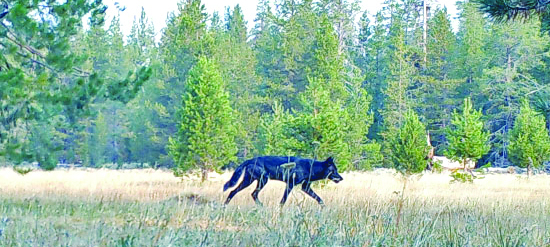BY Tim E. Hovey
Recently, I was talking with a friend of mine that just purchased some property in Mariposa County in central California. During the conversation, he stated simply that he hopes the wolves don’t find his place. At first, I thought he was kidding, then I started looking into the recent history of wolves in California.
Gray wolves are native to California, but starting in the mid-19th century, European colonizers begin hunting wolves to protect livestock. By the 1920’s, wolves had been extirpated, or completely removed from the state. In 2011 that all changed.
In 2011, a male wolf, part of a 2009 Oregon litter and tagged OR-7, entered California and became the first wolf to enter the state since 1924. OR-7 traveled thousands of miles through the Golden State before finally settling back in Oregon with a mate. Several wolves from that pairing have migrated and settled in California.
On the periphery, you may know of the occasional wolf present here in the state, but when I started recently looking into California wolf presence here, I was a bit shocked when I found out just how many live here.
As of February 2024, a total of six gray wolf packs calls California home. Wolf packs are defined as two or more wolves traveling together and using the same area within a given period of time. If wolf monitoring detects wolf reproduction and the use of the same general location within a six-month period, they are defined as a pack.
Currently there are 45 adults, yearlings and pup wolves in Plumas, Lassen, Tulare and Siskiyou counties, with additional wolf activity (wolves that have yet to be defined as a pack) in Sierra and Siskiyou counties.
On the heels of OR-7’s arrival to California, the State successfully listed the gray wolf as a fully protected species under the State’s endangered species act in 2014. Additional protection for the wolves is covered by the federal Endangered Species Act. This means killing a wolf will likely get you prison time.
In a little over ten years, California went from no wolves to a recorded 45 individuals running through six counties of the state. As those numbers continue to grow unchecked, we are going to start to see more human/wolf interactions. All you have to do is look at Oregon, Washington, Idaho and Montana to see where this is going. All four states are well above the Federal threshold for wolf recovery and two of the states (Idaho and Montana) and actively managing their packs with no real control in sight.
Wolves are going to do what they do. We can only wonder what’s going to happen when the California wolf numbers get beyond the carrying capacity of the state, and without proper management, they will. I guess we’ll just have to wait and see.




